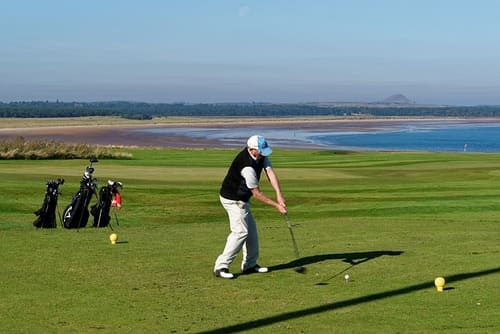A breakfast ball in golf is a term that refers to a mulligan or a do-over shot that is taken by a golfer during the first hole of a round. It is essentially a second chance given to the player to start their game on a better note. The breakfast ball is not an official rule in golf, but it is a widely accepted practice among casual golfers.
The origins of the term “breakfast ball” are unclear, but it is believed to have derived from the idea that if a golfer hits a poor shot off the first tee, they can go back and take another shot as if they were just starting their day. This allows the golfer to shake off any nerves or jitters from the initial tee shot and begin their round with a fresh start.
The breakfast ball is often used as a way to give players some leeway. This helps them feel more relaxed and confident from the beginning of their round.
The Origins and History of the Term Breakfast Ball
The term “breakfast ball” has an interesting history in the world of golf. While the exact origins of the term are unknown, it is believed to have emerged in the early 20th century. Back then, it was customary for golfers to enjoy a hearty breakfast before heading out for a day on the greens. And so, the term “breakfast ball” was coined to refer to the practice of taking a practice swing or hitting a second shot off the first tee, effectively giving oneself a second chance if the initial shot went awry.
In those days, golfing etiquette dictated that players had to tee off in the order of their handicap, with the best player leading the way. The use of a breakfast ball allowed players to have a warm-up shot before their official tee shot. This ensurs that they were ready to hit the ball properly when their turn came.
Over time, this practice became more widely accepted, and breakfast balls became a common occurrence on golf courses around the world. Today, the term has evolved to encompass any mulligan or extra shot taken on the first tee, regardless of whether it is in the morning or not.
Why Golfers Use Breakfast Balls
There are several reasons why golfers choose to use breakfast balls during a round. One of the main factors is the desire to improve their overall performance. Golf is an incredibly challenging sport, and even the best players can have off days.
By utilizing a breakfast ball in golf, players are giving themselves a second chance to start their round on a better note. This can help boost their confidence and set a positive tone for the rest of the game.
Another reason why golfers opt for breakfast balls is to save time and maintain a steady pace of play. Golf can be a time-consuming sport, and finding lost balls can significantly slow down the flow of the game.
By using a breakfast ball when their initial shot goes awry, golfers can quickly move on without spending too much time searching for the lost ball. This ensures that they stay on schedule and avoid frustrating delays for both themselves and their playing partners.

How Breakfast Balls Are Played
Breakfast balls are played as a second shot after the initial tee shot is deemed unsatisfactory. Once a golfer has hit their first shot and it does not meet their desired outcome, they have the option to take a breakfast ball. This means they can disregard their first shot, re-tee the ball, and take another swing without any penalty.
Essentially, the breakfast ball allows golfers to have a second chance at their opening shot, aiming for a better result.
The rules for playing a breakfast ball are relatively straightforward. After declaring that they want to play a breakfast ball, the golfer can re-tee their ball and hit another shot without incurring any penalties or adding strokes to their scorecard. It is important to note that the breakfast ball must be played immediately after the first shot. This means the decision to take a breakfast ball should be made before the golfer proceeds to the next shot.
So, once a golfer has moved on from the first shot, they cannot go back and decide to take a breakfast ball. Taking a breakfast ball provides golfers with an opportunity for a fresh start. Thus allowing them to reset and improve their overall performance on that particular hole.
Common Situations Where Golfers Use Breakfast Balls
One common situation where golfers may choose to use a breakfast ball is during friendly rounds or practice sessions. It is not uncommon for golfers to hit a poor shot on their first tee shot of the day, especially if they have not properly warmed up or are feeling a bit nervous. In this situation, using a breakfast ball allows the golfer to shake off any initial jitters and get into their rhythm for the round ahead.
Another situation where golfers might opt for a breakfast ball is when playing a new or challenging course. Golfers may underestimate the difficulty of a course, leading to unexpected struggles and frustrations. To avoid letting these difficulties negatively impact their game, golfers may choose to use a breakfast ball to give themselves a mulligan and a chance to start off on a better footing. By doing so, they can alleviate some of the pressure and potentially improve their overall performance on the course.
In both of these scenarios, the use of a breakfast ball serves as a tool to help golfers overcome obstacles and perform at their best. It provides an opportunity for a fresh start, allowing golfers to reset mentally and physically for a more successful round. While some golfers may view breakfast balls as an unfair advantage, particularly in more competitive settings, others embrace their utility and view them as a valuable part of the game.
Ultimately, the choice to use a breakfast ball in these common situations is a personal decision that each golfer will make based on their own strategies and goals on the course.
The Impact of Breakfast Balls on Golf Scores
Golfers often wonder how the use of breakfast balls affects their overall scores. While breakfast balls provide a second chance off the tee, their impact on golf scores can vary depending on the individual player and the specific situation.
For some golfers, breakfast balls can be a saving grace, allowing them to rectify a poor initial shot and salvage their score for the hole. It offers the opportunity to start fresh and approach the hole with renewed confidence. However, it’s important to note that using a breakfast ball doesn’t guarantee improved scores. Golf is still a game of skill, and even with a second chance, success depends on a golfer’s ability to execute their shot effectively.
Tips for Using Breakfast Balls Effectively
Golfers who choose to use breakfast balls can benefit from a few key tips to maximize their effectiveness on the course. Firstly, it is crucial to focus on maintaining a consistent swing when using a breakfast ball. This means maintaining the same swing tempo, grip, and alignment as you would with your regular ball. By doing so, you can ensure that your shots are consistent and allow yourself to adjust for any initial errant shots.
Another useful tip is to mentally approach your breakfast ball shots as practice shots. Rather than dwelling on the fact that it is not your primary ball. This mindset can help alleviate any additional pressure or frustration that may arise from a less-than-perfect shot and allow you to focus on improving your technique. Remember, the purpose of a breakfast ball is to give yourself a second chance. So embrace this opportunity as a valuable learning experience.

Pros and Cons of Using Breakfast Balls
Pros of Using Breakfast Balls
One advantage of using breakfast balls in golf is that it can help improve a golfer’s confidence and mindset. By allowing for a mulligan on the first shot, golfers have the opportunity to start off the round on a positive note. This can help them relax and focus better, leading to improved performance throughout the game.
Additionally, using breakfast balls can provide a sense of relief, especially for beginners or amateur golfers who may feel the pressure of performing well in front of others. It gives them a second chance to hit a better shot without feeling judged or criticized.
Cons of Using Breakfast Balls
However, relying too heavily on breakfast balls can have its downsides. One of the main drawbacks is that it may hinder a golfer’s development and skill improvement. By regularly using breakfast balls, golfers may become complacent and fail to address the issues in their swing or technique. This can result in a limited growth potential and hinder their progress in the game.
Moreover, consistently using breakfast balls can lead to a lack of accountability. Golfers may not take responsibility for their mistakes and may fail to learn from them. This can prevent them from developing the mental resilience and problem-solving skills necessary to excel in the sport.
Alternatives to Breakfast Balls in Golf
While breakfast balls are often used by golfers to improve their scores and alleviate pressure, there are alternative approaches that can be taken in the game of golf. One such alternative is the use of practice swings. Instead of hitting a breakfast ball, golfers can opt to take a few practice swings to loosen up. Allowing them to get into the rhythm before their actual shot. This can help improve accuracy and distance. As well as provide an opportunity to assess and adjust their stance, grip, and swing technique.
Another alternative to breakfast balls is employing mental strategies to overcome the pressure and anxiety that can arise on the golf course. Visualization techniques, for example, can be used to imagine a successful shot before actually hitting it. By picturing the desired outcome in their mind’s eye, golfers can enhance focus, confidence, and muscle memory to execute the shot effectively.
Additionally, deep breathing exercises and mindfulness techniques can be employed to calm nerves, reduce tension, and promote a more relaxed and composed state of mind. These alternatives can be effective in managing the challenges of the game without the need for a breakfast ball.
Summary
Players around the world have mixed opinions on the use of a breakfast ball in their golf game. While some view it as a practical and beneficial technique, others consider it unnecessary and even unfair. Ultimately, the decision to employ breakfast balls on the course comes down to personal preference and individual circumstances.
One school of thought suggests that breakfast balls can be a helpful tool for beginner golfers or those struggling with consistency off the tee. By allowing a golfer to hit a mulligan of sorts on their first shot, it provides them with an opportunity to start their round on a positive note. This can boost confidence and potentially lead to improved performance as the game progresses.
On the other hand, there are those who argue that relying on breakfast balls can hinder a golfer’s progress and inhibit the development of crucial skills. An overreliance on this technique may prevent players from facing the consequences of poor shots. This robs them of the chance to learn from their mistakes and adapt their strategy accordingly.
Additionally, in competitive golf settings, using breakfast balls may be frowned upon and seen as a violation of the traditional rules of the game. Purists argue that golf should be a test of skill and mental fortitude. In their eyes, accepting the outcomes of each shot, good or bad, is an integral part of that challenge.
Final Thoughts
In conclusion, the use of breakfast balls in golf is a contentious topic with valid arguments on both sides. Whether one chooses to adopt this practice or not depends on various factors, such as skill level, personal goals, and the specific circumstances of the game. Ultimately, striking a balance between enjoyment and growth as a golfer is key. Each player must make a decision that aligns with their individual needs and aspirations.
FAQs
What is a breakfast ball in golf?
A breakfast ball in golf refers to the practice of hitting a second tee shot without penalty if the first shot did not go as planned.
Where did the term “breakfast ball” come from?
The term “breakfast ball” originated from the idea that golfers often play early in the morning and might need a warm-up shot to start their round.
Why do golfers use breakfast balls?
Golfers use breakfast balls to give themselves a second chance if their initial tee shot is not satisfactory. It helps them avoid penalty strokes and reduce their frustration.
How are breakfast balls played?
After hitting an unsatisfactory tee shot, golfers typically inform their playing partners that they will take a breakfast ball. They then hit another tee shot without penalty.
In what situations do golfers use breakfast balls?
Golfers often use breakfast balls when they feel nervous, under pressure, or simply want to start their round on a positive note. It is commonly used on the first tee or after a particularly poor shot.
What impact do breakfast balls have on golf scores?
The use of breakfast balls can potentially result in improved scores as golfers get a chance to correct their mistakes without penalty strokes. However, it ultimately depends on the individual’s skill and ability to capitalize on the second opportunity.
Any tips for using breakfast balls effectively?
It is important to mentally reset after hitting a poor shot and not let it affect the second shot. Additionally, using breakfast balls sparingly and only when necessary can help maintain the integrity of the game.
Are there any alternatives to breakfast balls in golf?
Yes, golfers can choose to play a provisional ball instead of taking a breakfast ball. A provisional ball is played when the original shot might be lost or out of bounds.





